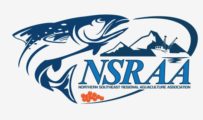Read about NSRAA’s salmon research here: 2024 Crawfish Inlet Chum Homing Technical Report
2013 ADFG-NSRAA Crawfish Inlet Site Selection Report: Summary of the ADFG Consideration of NSRAA Request for Potential New Salmon Enhancement Sites/Opportunities
Crawfish Inlet’s chum program is a Medvejie Hatchery satellite program (remote release) permitted for 30 million eggs (reared at Sawmill Creek Hatchery) and designated the Crawfish Terminal Harvest Area (THA) for troll priority and Cost Recovery. Thanks to some hard work and ingenuity, Crawfish Inlet went from concept to permit, to fish in the water within a twelve-month time period. NSRAA has never executed a quicker timeline. The rearing net pens are located 40 water-miles south of Sitka, deep within the Crawfish fjord. ADF&G permitted the program in the spring of 2014 and eggs were taken at Medvejie in September. Fifteen million eggs were obtained in the first year due to programmatic and brood stock constraints, with the full 30 million eggs being achieved in 2015 and beyond. As has become standard with NSRAA, either all or a portion of this chum release is reared to 4 grams, a strategy expected to maximize marine survival. Additionally, the site is permitted for a Chinook Salmon release from up to a 2-million egg-take each year.
At the program’s inception, the goal was to produce 700,000 adult chum salmon for common property harvest beginning in 2018 with the first four-year-old’s. Expectations for marine survival were modest and reflected historical averages of Deep Inlet released chum (ranging between 0.5% and 3.5%). What actually happened exceeded everyone’s imagination. The first four brood years all returned at over 5% marine survival with brood year 2015 experiencing a staggering 16.6% marine survival, the highest ever recorded for a NSRAA project. The majority of these brood year 2015 fish returned in 2018 as three year-olds, which was especially unusual given historical age at return for this stock was well under 20% for three year old’s. This phenomenon led to a massive influx of chum salmon into Crawfish Inlet and West Crawfish Inlet in the peak weeks of the 2018 season, prompting for commercial seine fishing to occur alongside troll and cost recovery to keep up with the continuous build of chum salmon in the area. On August 30, over 1 million fish were harvested in a single day (see video), the largest single-day chum salmon harvest in state history. By the end of the 2018 season, the project gathered the highest annual value of any fishery in the history of NSRAA at over 26 million dollars.
In the years following, marine survivals have steadily crept down towards more realistic and normal levels. Annual return estimates continue to be difficult to forecast, however, due to this site’s tendency to produce much younger fish. Trollers from Sitka continue to utilize this project, especially the West Crawfish Inlet corridor which has proven to be the primary migration route for adult chum salmon homing in on the head of Crawfish Inlet. The site, having exhibited such phenomenal early survival, quickly became a de facto cost recovery site for the majority of NSRAA’s chum salmon revenue. However, by 2023, due to increasing budget needs and the normalization of survival, NSRAA has begun pursuing additional sites for cost recovery needs
In order to minimize straying of returning chum salmon, regulations require that NSRAA mop up the terminal harvest area one day each week through a cost recovery harvest or a seine rotation. Scrutiny over potential for stray fall stock hatchery fish in summer stock streams have prompted aggressive early fishing annually and a robust evaluation of this return. Studies are now underway to examine the migration and imprinting patterns of hatchery reared fry leaving Crawfish Inlet (first data expecting to be collected in 2023).
In the years following the legendary 2018 return to Crawfish Inlet, NSRAA had never been in a healthier financial position. The surplus of cost recovery needs in 2018 allowed for NSRAA to continually “forward fund” the annual budget each year and has allowed flexibility in funding options for other new programs. The return on investment for Crawfish Inlet chum production remains much higher than any other NSRAA program and is a true success story for our association.
Crawfish Inlet (star is rearing site location)
Click on image to enlarge.




